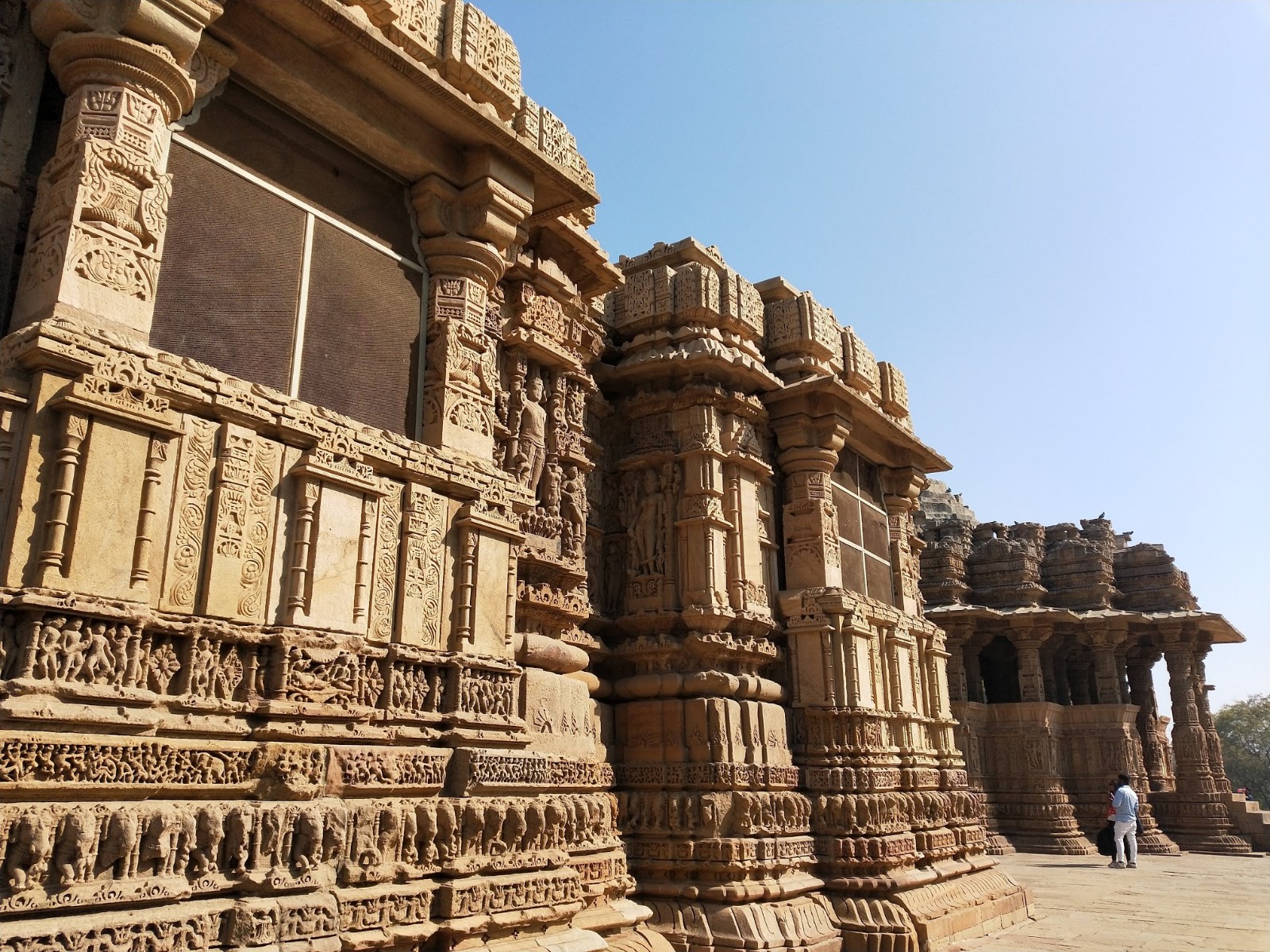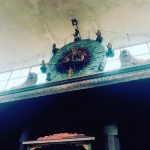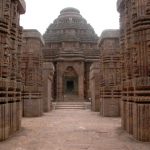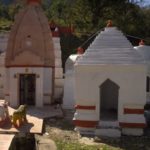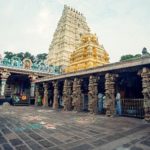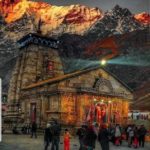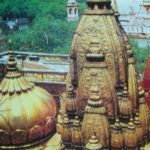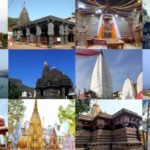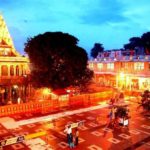There are 2 Sun Temples in India – first one in Konark and then the other one is this.
Modhera Sun Temple which is situated on the banks of river Pushpavati is believed to be built around 1026-27 CE during the rule of Rajput King Bhimdev Solanki of the Chalukya dynasty.The temple is built on 23.6 degrees latitude (from where the Tropic of Cancer passes). Patan – which is a city 32 km from Modhera, Gujarat, was the then capital city however this temple was built in Modhera keeping in mind it’s location ie the Tropic of Cancer. The artisans who built it came from Sompura, Rajasthan and it took 40 yrs to build. The stones were brought from a city 110 km far from this village.
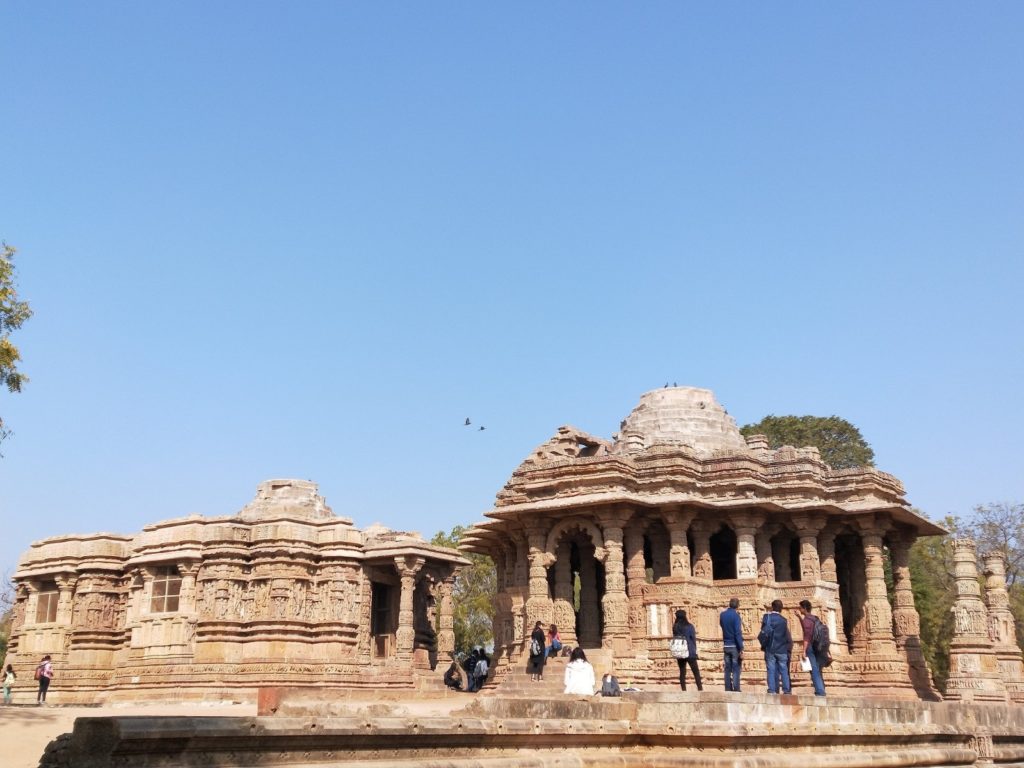
Carving on a sandstone is very difficult however this temple has carvings as deep as 1.5 ft. It is built with 2 diff interlock systems called pillar and platform interlock systems. One is through 4-5 parts joint through the male-female interlock system (like stone inside a stone). The 2nd was two portions of a cracked rock locked with a piece of wood.
It used to host a Golden Statue of the Sun God with a Gold crown and a diamond, and a lot of jewels that was worshipped for 50-60 yrs. In 12th century, Khilji attacked the temple and broke every figurine including the top. For 900 yrs the top was open and there was rain water and sun coming in. Later it was repaired by the Central Govt between 1975 to 1995, so you can now see the cemented tops.
This however is no longer a place of worship after the deity was stolen, and now protected and maintained by Archaeological Survey of India as a monument of National Importance.
The temple is an example of how even 1000 yrs back, Vaastushastra and Science were so ahead of times in India. The temple has three components – Gudhamandapa (Shrine Hall); Sabhamandapa (Assembly Hall) and SuryaKunda (Reservoir).
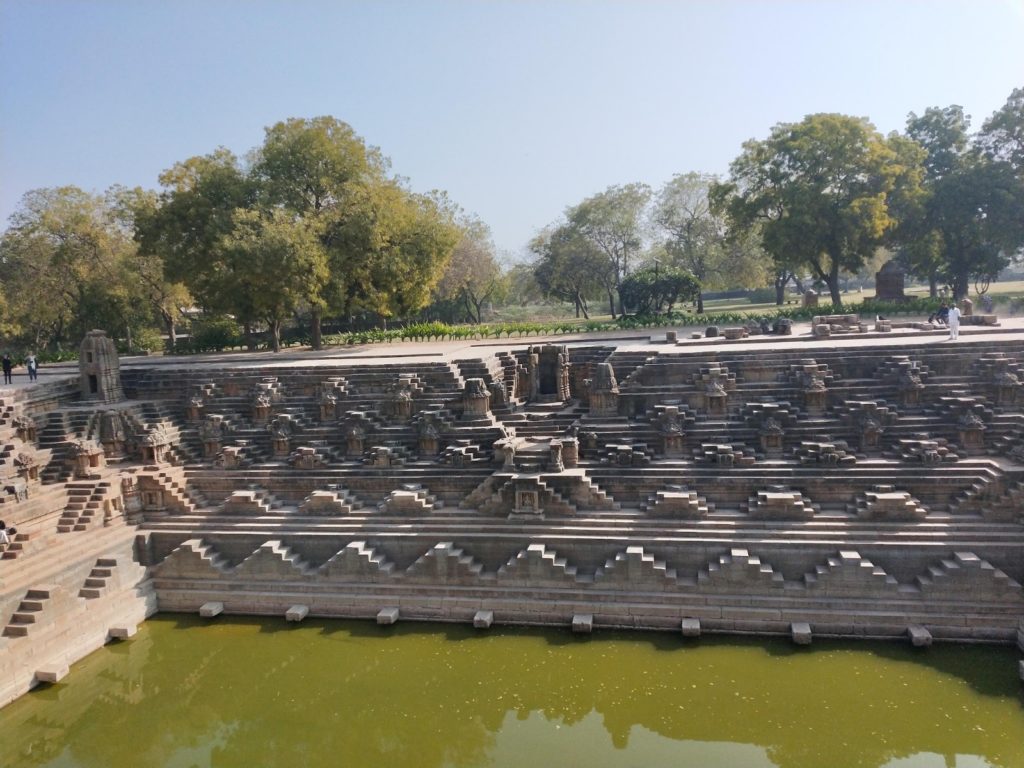
We start at the SuryaKunda – reservoir or the step well which has 108 big and small temples of different Hindu Gods and Goddesses carved all around, depicting the 108 prayer beads of the Rudraksha mala. The bigger temples around the edges are that of Lord Ganesha, followed by Shitala devi with her mount – the Donkey, Sleeping Vishnu, Mahakali and then Nataraja. The entire temple is made of sandstone to avoid fast erosion due to rain or wind. The triangular steps in a series of 3 in two different directions which were believed to be so, to allow men and women to climb down in different directions to avoid accidents. The water in this well is 20 ft deep, and in the yesteryears was pure spring water but now fills with rain water. Bathing and witnessing 108 Gods and Goddesses just after is considered Holy.
We proceed next to the 2nd part of the temple ie the Sabhamandapa (Assembly Hall or Meeting and Dancing hall). This structure represents the yearly calendar.
The temple is built in 11 steps:
- Lotus (Kamal) as the base
- Kani (Design of the leaf)
- Rajsinhasan or the king’s seat
- Gaja or Elephant which represents Samriddhi or Prosperity
- Birth and Death formations
- Kumbha
- Kalash (Earthen pot with Sreephal)
- Manch and Maachis
- Wooden table and cloth aasana to seat the diety
- God and Goddess statues
- Shikhara at the top
It demonstrates the yearly calendar. The 365 days of the year are depicted through 365 carved elephants at the 4th step – and each elephant is uniquely designed. It has 52 intricately carved pillars depicting the 52 weeks of the year – 13 in each of the 4 directions. The 12 months depicted by the 12 Sun God deities and 12 forms of Parvati called Adarsh Gauri at 10th layer. The Sun God deity is riding on 7 horses which depicts the 7 days of the week. The Sun God is symbolized usually with 7 horses and then with 2 Lotus flowers in both the hands which si both depicted in the architecture of this temple.
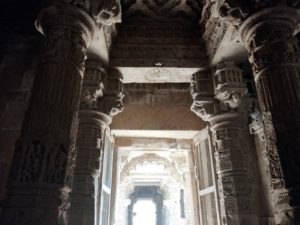
Each of the 52 pillar carvings shows Dharma, Artha, Kama and Moksha stages. Dharma depicted in the events from Ramayana and Mahabharata event. We could see Sita maiyya sitting in Ashok Vatika and Hanuman sitting near her feet, Ravana coming to take alms from Sita dressed up as a monk, Ravana kidnapping Sita and Jatayu the vulture’ tryst to save her, the injured Lakshman with Hanuman flying with the entire mountain having Sanjeevini booti, Bali-Sugreev fight, building of the Ram Setu bridge by Vanar Sena, Ravana’s brother Kumbhakaran and the Varah avatar of Lord Vishnu from Bhagvatpurana.
Then we had little Krishna churning butter, then a game that little Pandavas and Kauravas played where they have to climb up a tree and the one down has to touch them – Bhima being the stronger one, shakes the tree and all the kids fall down, Krishna holding the Govardhan mountain on his little finger, Bhima and Ashwatthama elephant’s fight, the death scene of Duryodhana during the Gada Yuddha with Bhima.
The outside the carvings represent the stages of life – birth and death. 1000 yrs back there were no doctors, but the carvings represent how a child is born, the delivery posture of a woman, the celebrations post child birth with music, the funeral of the dead body taking him on 4 shoulders and other figurines representing Kamasutra. Then there are carvings depicting dance festival – Bharatnatyam, Kathakali.
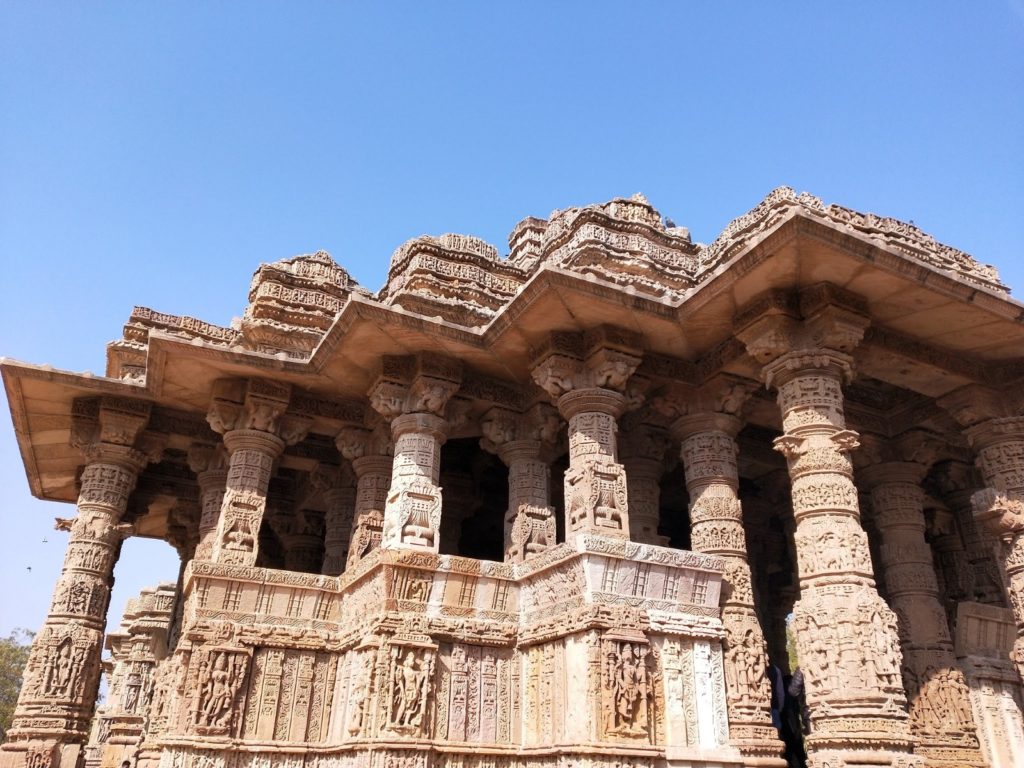
Vaastushastra.
- The NE corner – Ishan Kon which is considered as the lucky entrance and was used as the main entrance 1000 yrs back. The 2 entrace pillars formed the entrance and then is decked up with carved Keerti Torans. Today when we talk about directions, as per Vaastu, we stage our Pooja Rooms in the NE direction.
- Then North facing direction shows Lord Kuber where and we keep our lockers – money and gold in this direction.
- NW corner shows Air God or Vayu Dev and this is where we should have the windows to allow good ventilation.
- West direction of the temple has the statue of Rain God or Varun Dev where we should keep drinking water and it will reduce diseases.
- SW corner stages Nairutya dev in Digambar Avastha. So SW corner is where we should have the bedroom.
- Then South facing shows Yamraj and as per Vaastu we should have washroom in that direction.
- SE corner shows the God of Fire and is called Agni kon where we should have our kitchen. The Fire God is depicted with flame behind his head and has a Sheep as his mount. We can see a Laddoo kanya with prasad which depicts that this is a kitchen and is shown no where else in the architecture of the temple.
- East direction shows Indra and shows where the main entrance should be.
On the 10th stage of the temple we can see statues of different deities like – Kaalbhairava, Parvati statue representative of her shringar and style. The Parvati statue has a smiling face and the smile seems to grow wider as you view it from a distance. We see the Architect God Vishwakarma – the hands were again broken by Khilji but used to have a scale in his hands and he has been said to have constructed Dwarka and Lanka nagris. At the very top we also see Saraswati that depicts that education was always top priority. Then you see deities of Vishnu and Sheshnag, Sleeping Vishnu and Lakshmi, Karthikeya (Murugan/Subramanya) on his peacock, Apsaras, Ardhanareshwar and Ganesha.
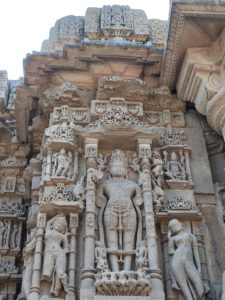
The carvings depict the biggest festival of Gujarat ie Navratri – where figurines are seeing playing Dholki and Garba. You also see depictions of the Gauri Vrata, Samudra manthan, love between a mother and her son where the son is seen worried when the mother gets pricked on her foot by a thorn.
Then we enter the 3rd part which is the main temple – Gudhamandapa. The entrance is through the Sringar Chauki – which starts with Lord Ganesha, followed by Kuber, Apsara and Dwarpal. Then at the main gate at the top we have the Tridev – Brahma, Vishnu and Shiva. The entrance is decked up with carved Torans for decorations.
The inside pillars showcase the different Shringar forms – different positions of apsaras with different jewellery adorned – earrings, belt, anklets, different hairstyles. The pillars also showcase the steps of a woman’s life – the carvings depicting the 5 day menstruation cycle, romance positions, Kamasutra, the pregnant woman, the villagers crossing the river to take the mother for delivery and then the mother holding her child.
Down there are a stairs that led to a Meditation Room which was closed by the Govt. to avoid garden snakes from getting inside. The Garbhagriha inside used to have a 8 ft gold filled with jewels and then a 5ft Gold statue of the East facing Sun God riding on 7 horses, with his crown holding a Diamond, all of which Khilji stole in the 12th century and damaged the temple.
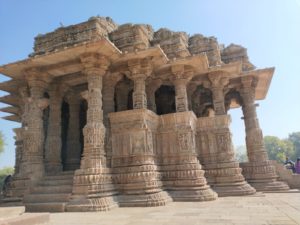
At 23.5 degrees ie Tropic of Cancer, on the Equinox days ie 20th Mar and 23rd Sept when the sun crosses the celestial equator and day and night are of equal length, the first rays of the sun used to fall on this Sun God’s crown diamond and with it’s reflection, the temple used to light up in different colors. Hence Modhera being the chosen place rather than the then capital Patan. Talk about Science!
We were filled with pride and ecstasy and also a little saddened with the damage that such jewels of our country have undergone.




